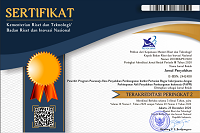Persepsi Peternak tentang Penerapan Inseminasi Buatan di Tiga Sentra Sapi Potong di Indonesia
Abstract
The general objective of the research is to describe and analyze implementation of adopted artificial insemination (AI) innovation on slaughter cattle’s farmers. Specifically, is to describe and analyze the perception of slaughter cattle’s farmers on AI in the three locations of research. Locations of the research are Kecamatan Geger Kabupaten Bangkalan and Kecamatan Mantup Kabupaten Lamongan in East Java Province and Kecamatan Penebel Kabupaten Tabanan in Bali Province. This research was designed as a correlation descriptive survey by both quantitative and qualitative approach. The number of sample is 240 respondents -who is the acceptors of AI- and by approach of stratified random sampling method. Data collection was completed with questionnaires, interview and field observation. Kruskal-Wallis Test and U Mann-Whitney Test were applied to analyze the data sample. The result of the research showed that the perception of the farmers on most of AI’s aspects are significantly different among locations of the research, with the exception of the phenotipe (physical appearance) of breed cattle and the artificial insemination services by inseminators. To be suggested that socialization or extension on AI should be conducted by different approaches to fit the characteristic of internal and external and AI’s perception of the farmers.
Keywords: Perception, artificial insemination
Downloads
Authors who publish with this journal agree to the following terms:
- Authors retain copyright and grant the journal right of first publication with the work simultaneously licensed under a

This work is licensed under a Creative Commons Attribution 4.0 International License that allows others to share the work with an acknowledgement of the work's authorship and initial publication in this journal. - Authors are able to enter into separate, additional contractual arrangements for the non-exclusive distribution of the journal's published version of the work (e.g., post it to an institutional repository or publish it in a book), with an acknowledgement of its initial publication in this journal.
- Authors are permitted and encouraged to post their work online (e.g., in institutional repositories or on their website) prior to and during the submission process, as it can lead to productive exchanges, as well as earlier and greater citation of published work (See The Effect of Open Access).















